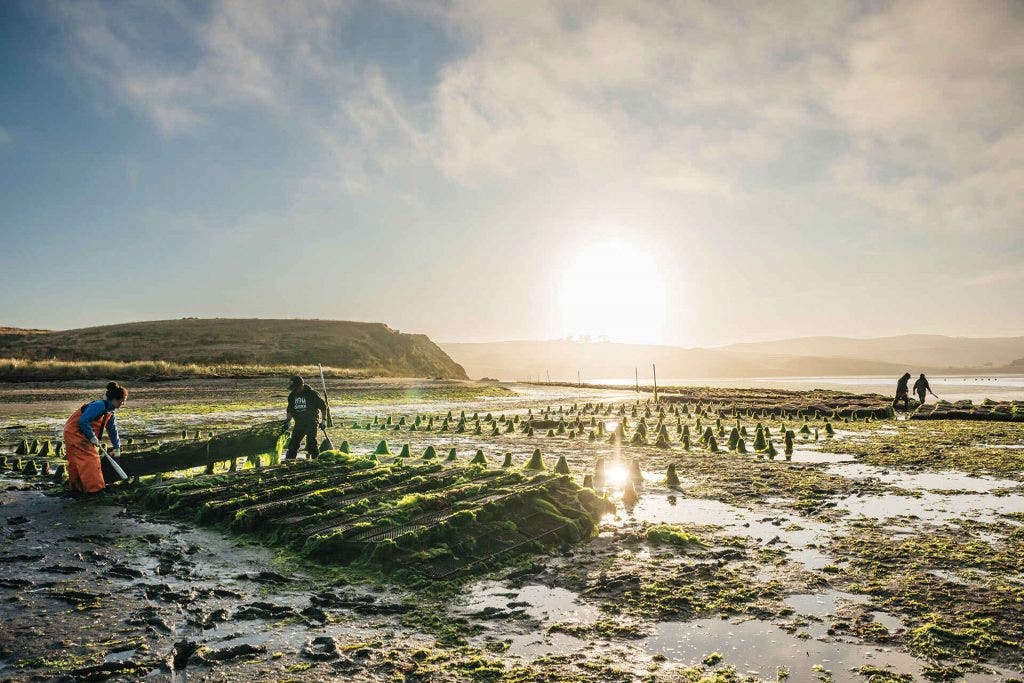You can’t talk about this country’s waterways and coastal histories without oysters. The United States’ estuaries (where rivers meet the sea), such as Chesapeake Bay and Puget Sound, were largely comprised of oyster reefs, which purified the water, gave habitat to other marine life and provided stability to shorelines.
Just as important, they were one of the most abundant food sources for millennia. There are middens (shell deposits) in the U.S. that show continuous oyster consumption for over 5,000 years. Florida’s Mound Key, south of Fort Myers, contains the shells of almost 20 billion oysters that were harvested by the Calusa tribe.
“Cicero ate oysters to nourish his eloquence, and the ancients used them with a startlingly cold-blooded combination of gastronomy and pure hygiene.”
M.F.K. Fisher, from “Consider The Oyster” (1941)
These ancient middens show no reduction in oyster size or quantity over time, suggesting that indigenous people practiced sustainable fishery that colonial populations did not even think of. Until the late 1800s, oysters were so abundant as to practically be free, but by the close of the 19th century, overfishing, disease and pollution collided to spark a slow decline. Today, there are virtually no wild oysters sold commercially.
The good news is that farmed oysters are a net positive for the environment. A single adult oyster can filter up to 50 gallons of seawater a day. The so-called “oyster liquor”—the delicious liquid inside a just-shucked oyster—is just filtered seawater.

There are many advantages to (non-oyster) aquaculture in terms of providing a high-quality food source, employment, ecological balance and more. However, it can also involve drugs and chemical disinfectants, large quantities of fish feed, pollution by waste products and excess nutrients and complex equipment that negatively affects the sea floor.
Oyster farming, on the other hand, has virtually none of these downsides. Because oysters are stationary beings—making just a single real estate decision their entire lives—that require no feed and purify, rather than pollute, the water, it’s more akin to growing plants in a nursery. As a bonus, farmed oysters have a better and more reliable shape, size and taste than wild.
The shells from oyster consumption can be returned to the water with oyster “seed” (oysters are very fertile; a single male and female oyster can create millions of babies) to restore oyster reefs. In the wild, oysters like to settle and grow on other oysters or oyster shells. These reefs can help prevent coastal erosion, provide habitat for vulnerable marine creatures and help restore wild oyster populations that eventually could deliver the same environmental benefits without human intervention.
In other words, you can think of eating oysters as an ethical, and delicious, imperative.
Crucial Considerations When Opening an Oyster
- Find an opening near the hinge where you can wiggle the tip of the knife between the top and bottom shells.
- Slide it in parallel to the top of the shell gently, above the oyster meat. Use a back-and-forth twisting motion with your wrist, rather than poking or stabbing straight down.
- As the knife goes in, turn the knife like you would a door knob to pop the shells apart.
- Try not to spill the “liquor.”
Beverage Pairing with Raw Oysters
For such a simple and pure bite of food, oysters on the half-shell inspire a lot of debate about what to drink with them. This is not because they’re difficult to pair with, but just the opposite. The hit of brine contrasted with a cucumber-like sweetness lets you go in myriad directions:
Crisp and Mineral White Wines
Chablis and Muscadet are often cited as ideal pairings for their acidity and vaguely saline or seashell minerality, but add Albariño and Assyrtiko to that list. They all share qualities with the oysters themselves, for a complementary, rather than contrasting, pairing.
Champagne
At least for the time being, oysters are a luxury, and Champagne amps up the level of luxe. It also has the acidity and minerality that go so well with raw oysters. And if yours happen to have stronger flavors or richer toppings, the bubbles help cleanse the palate.
Sweet Wine
The sweet and salty combination is nothing new: Sweet wine and oysters were the assumed pairing in much of the world in the 1800s. Sauternes is lovely—perhaps because the funk of botrytis has an affinity with shellfish—but any sweet wine with balancing acidity is an addictive accompaniment.
Stout Beer
In oyster-loving Ireland, you might be ostracized for not drinking a Guinness with your oyster—and it’s not just patriotism. Stouts are more malty (sweet) than hoppy (bitter), with a silky texture that goes with creamier oysters, while accentuating the “pop” of crisper ones. Each teases the sweetness of the other.
Dry Cider
Ciders range from bone dry to sugary sweet, but always with a crisp-tart appley flavor that could almost be used directly on oysters in place of mignonette. Still, for the best pairing, look for one labeled “off-dry” or “semi-sweet” for a sweet-tart-salty flavor combo.
Sake
There’s good reason that sake is a default pairing with raw seafood in Japan. Whether crisp and dry or milky and sweet, sakes have a lush fullness of flavor that is especially good with larger and brinier oysters with creamy or chewy textures.
Wine Pairing with Cooked Oysters
The heartier flavors of cooked and prepared oysters demand different wines. We asked chef Christopher Haatuft of Houston’s Golfstrømmen (and a Norwegian restaurant empire) and his consulting wine director Mads Kleppe for their thoughts on prep and pairing, respectively.
Steak and Oyster Tartare
Haatuft: “Raw, lean beef or whale—I know, but I’m Norwegian, so sue me—has some of the same iodine flavors as briny oysters. We mix them and dress with fine shallots, mixed herbs, chopped housemade pickles and a fruity olive oil.”
Kleppe: “For this mineral yet exotic serving, I like aromatic wines with good acidity and freshness, like cool-climate Riesling or Sylvaner. As a more experimental choice, a Pét-Nat could be fun and delicious.”
Broiled or Fried Oysters
Haatuft: “Though I’m Norwegian, my mother is from Tennessee, so I have a craving for Southern food. Cornmeal fried oysters with a sour cream ranch dressing is the perfect snack. And for bigger oysters like Gulf oysters or wild Belons, we mix butter with grilled scallions, chili and panko.”
Kleppe: “Whether broiled or fried, try a luxurious combination with Champagne, especially one on the richer side, like a Blanc de Noirs based on Pinot Noir.”
Oyster Soup
Haatuft: “We base ours on a traditional fish soup from Bergen. It’s made with a powerful fish stock—no dainty French fûmet here!—thickened with sour cream, beurre manié, egg yolk and more sour cream, with vinegar for acidity and finished with a touch of sugar. The oysters are gently poached in the warm soup. It’s usually the best fish soup anyone has tasted, but it might give you a heart attack.”
Kleppe: “This deserves a rich and full-bodied white wine, like good Chardonnay from prestigious villages in Burgundy or exciting producers in the cooler regions of California. Regardless, find one with good acidity to play with the creamy textures and flavors of this amazing soup.”
Give oysters a try with our recipe for oven-roasted oysters with bone marrow and pistachios or serve fresh oysters alongside a white wine mignonette.
Oyster-Reef Restoration Projects You Can Support
This article originally appeared in the February/March 2023 issue of Wine Enthusiast magazine. Click here to subscribe today!




